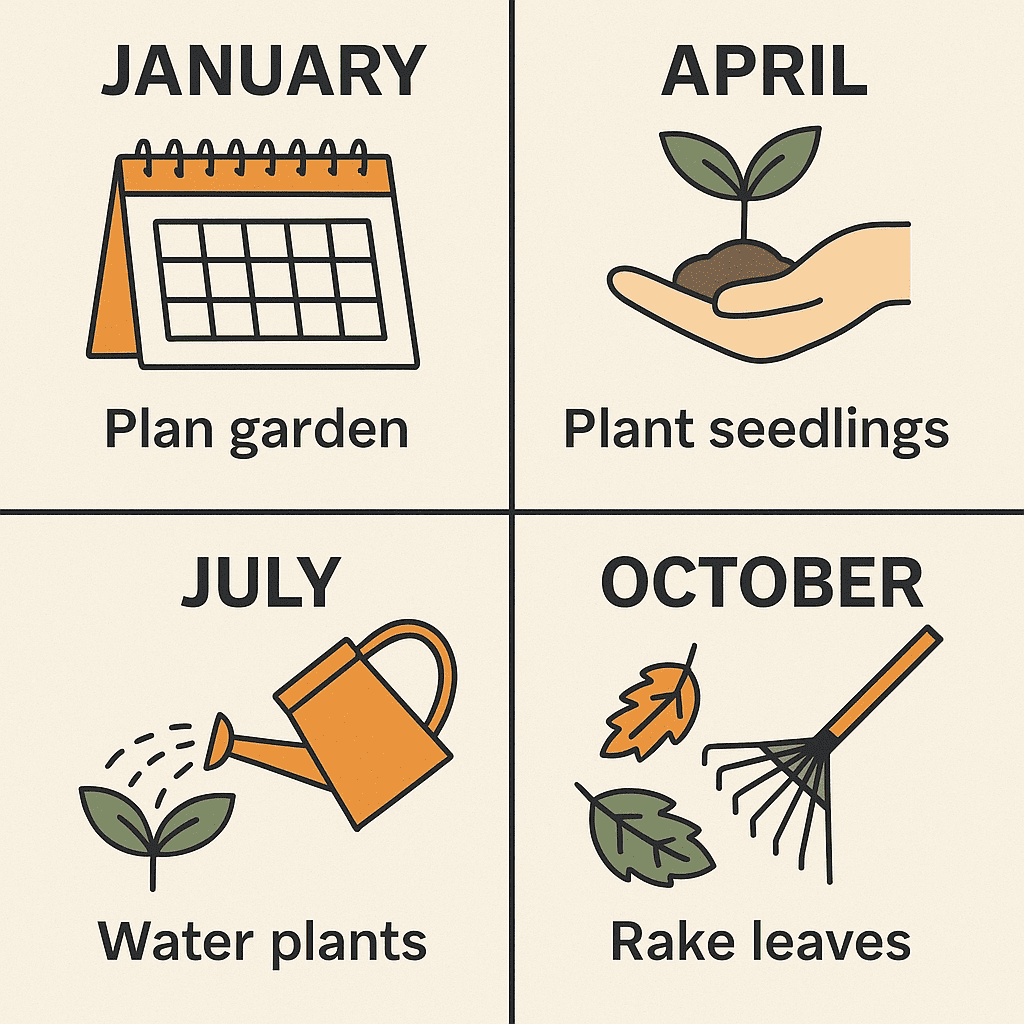Successful gardening isn’t just about watering and sunlight — it’s also about understanding seasonal plant care and what to do each month to keep your plants thriving all year long. Each season presents unique challenges and opportunities, and adjusting your plant care routine accordingly can significantly boost growth, health, and resilience.
Whether you’re managing a lush outdoor garden or a few pots on a balcony, this month-by-month guide will help you plan and maintain a vibrant green space all year round.
Why Monthly Plant Care Matters
Plants have natural cycles of growth, rest, flowering, and dormancy. Following a seasonal care routine ensures you:
- Maximize blooming and fruiting periods
- Reduce risk of pests and diseases
- Avoid overwatering or underfeeding
- Keep soil nutrients balanced
- Prepare for climate and daylight changes
Let’s break down plant care by month, focusing on the needs of both indoor and outdoor plants.
Monthly Plant Care Calendar
🌱 January: Planning & Indoor TLC
- Plan your garden layout and order seeds early
- Prune indoor plants and remove dead foliage
- Reduce watering and fertilizing for dormant plants
- Clean pots and tools for spring preparation
Tip: Place indoor plants near windows to maximize natural light during shorter days.
🌿 February: Start Seeds Indoors
- Begin seed starting indoors for vegetables and flowers
- Check overwintering bulbs or stored tubers
- Inspect houseplants for signs of pests
- Add humidity if air is dry
Rotate houseplants to encourage even growth.
🌸 March: Prep for Spring
- Prune roses, shrubs, and dormant perennials
- Start hardening off seedlings
- Clean garden beds and remove debris
- Begin composting again as temps rise
Apply slow-release fertilizer to outdoor containers.
🌷 April: Spring Planting Begins
- Plant cool-season vegetables outdoors (lettuce, peas, carrots)
- Divide perennials like hostas or daylilies
- Refresh potting soil in containers
- Mulch garden beds to retain moisture and suppress weeds
Water deeply but less frequently to encourage strong roots.
🌞 May: Peak Growth Season
- Transplant warm-season vegetables (tomatoes, peppers)
- Fertilize regularly (every 2–3 weeks)
- Stake or trellis climbing plants
- Monitor for aphids, snails, and other pests
Deadhead flowers to extend blooming period.
🌻 June: Maintenance & Monitoring
- Water early in the morning to prevent evaporation
- Apply organic mulch where needed
- Thin out crowded seedlings
- Watch for powdery mildew or rust on leaves
Keep a garden journal to track what’s thriving or struggling.
🔥 July: Beat the Heat
- Increase watering frequency for containers and shallow roots
- Use shade cloths or reposition potted plants
- Stop fertilizing new growth to reduce stress
- Harvest herbs before they flower
Avoid pruning during peak heat to reduce plant shock.
🍅 August: Harvest & Refresh
- Harvest mature vegetables and fruit frequently
- Begin planning fall planting schedule
- Cut back leggy annuals to promote regrowth
- Start second plantings of fast-growing crops
Collect seeds from healthy plants for next season.
🍁 September: Transition to Fall
- Plant fall crops like kale, spinach, and broccoli
- Prune lightly to shape perennials
- Reduce watering as temperatures cool
- Bring tender houseplants indoors gradually
Add compost to improve soil before winter.
🍂 October: Clean-Up & Mulch
- Rake and compost fallen leaves
- Remove spent annuals and weeds
- Divide spring-flowering bulbs
- Apply thick mulch to protect soil from winter freeze
Clean and store garden tools after use.
❄️ November: Prepare for Dormancy
- Cover raised beds with straw or burlap
- Wrap vulnerable shrubs with frost blankets
- Water evergreens thoroughly before ground freezes
- Store hoses and shut off outdoor faucets
Check indoor plants for spider mites as heating begins.
🎄 December: Rest & Reflect
- Keep indoor plants away from heat vents
- Limit watering to avoid root rot
- Review gardening journal for the year
- Plan improvements or new additions for next season
Decorate with evergreen cuttings or seasonal plants like poinsettias.

Bonus Tips for Year-Round Success
- Observe your microclimate: Balconies, patios, and indoor areas vary in sunlight and wind exposure.
- Use a calendar or reminder app: Stay consistent with monthly tasks.
- Adjust based on plant type: Succulents, tropicals, and vegetables all have different needs.
Recommended Tools and Resources
You can find durable gardening gloves, pruning shears, and soil testers at Gardener’s Supply Company.
Internal Resource
Want to master one of the most important parts of this routine? Learn all the essentials in our guide to watering plants correctly.
Looking to make your seasonal plant care even more sustainable? Check out our guide on DIY planters made from recycled materials.
Conclusion: Let Nature Set the Rhythm
Understanding seasonal plant care allows you to work with nature, not against it. Month-by-month adjustments help ensure healthy growth, lush blooms, and a more enjoyable gardening experience all year long.
🌿 Save this guide for your next planting weekend!
🌼 Share this with a friend who wants a thriving garden too!
FAQ – Seasonal Plant Care
Do indoor plants follow the same seasonal cycle?
Not exactly. Indoor plants are less affected by outdoor temperatures but still respond to daylight changes. Adjust watering and feeding during winter dormancy.
What if I live in a tropical or desert climate?
You’ll need to adapt the calendar. Focus on your local growing seasons and avoid overwatering during high humidity or rainy months.
Should I fertilize every month?
Only during active growing seasons (spring/summer) for most plants. Dormant periods like winter require minimal or no feeding.
You can find high-quality garden tools, frost blankets, and composting supplies at Gardener’s Supply Company.
Written by Kate Smith | Plant Care Enthusiast & Urban Gardener
